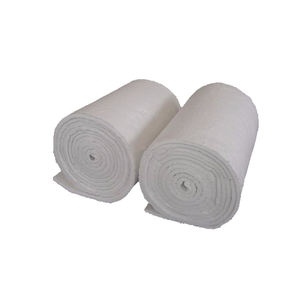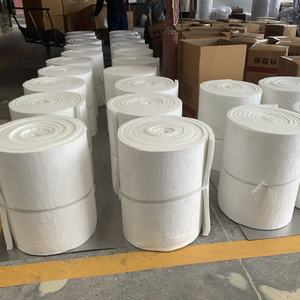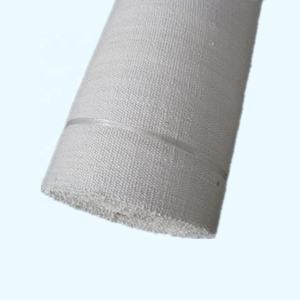Professional industry ceramic supplier, silicon nitride, silicon carbide, aluminum nitride and any other kinds of ceramics.
PRODUCT PARAMETERS
Description
Overview of Low conductivity ceramic fiber insulation
Low conductivity ceramic fiber insulation is a lightweight, high-temperature insulation material composed primarily of alumina-silica. It is manufactured through a melting and spinning or blowing process, resulting in a flexible, wool-like textile. This material is engineered to provide exceptional thermal management, conserving energy and protecting equipment in extreme temperature environments across various industries.
Features of Low conductivity ceramic fiber insulation
-
Excellent Thermal Stability: Withstands continuous operating temperatures up to 1260°C (2300°F) and higher for certain grades, with minimal shrinkage.
-
Low Thermal Conductivity: Provides highly efficient insulation, reducing heat loss and improving energy efficiency.
-
Lightweight & Low Heat Storage: Offers low thermal mass, enabling rapid heat-up and cool-down cycles for improved process control and energy savings.
-
Thermal Shock Resistance: Highly resistant to damage from rapid temperature changes.
-
Excellent Flexibility & Resilience: Can be fabricated into blankets, boards, papers, and textiles to fit complex shapes and applications.
-
Good Chemical Stability: Resists attack from most corrosive agents, except strong alkalis and hydrofluoric acid.
Specification of Low conductivity ceramic fiber insulation
Low conductivity ceramic fiber insulation offers exceptional thermal protection. It handles intense heat effectively. This material withstands temperatures reaching high levels. Ceramic fiber is made from alumina and silica. These materials create a lightweight, flexible product. The insulation looks like wool. It feels soft to the touch. Installing it is straightforward. Workers cut it to fit specific spaces easily.
The key advantage is its low thermal conductivity. Heat struggles to pass through this insulation. It keeps heat inside furnaces, kilns, and boilers very well. This improves energy efficiency significantly. Less fuel is needed to maintain desired temperatures. Operating costs decrease as a result. The material also stores little heat itself. Furnaces cool down much faster after shutdown. Production cycles become quicker.
Ceramic fiber insulation provides good chemical stability. It resists most chemicals found in industrial settings. This insulation handles thermal shock effectively. Rapid temperature changes cause minimal damage. The material lasts longer under tough conditions. It requires less frequent replacement. Maintenance costs stay lower.
This insulation is ideal for high-temperature applications. Use it in furnace linings, backup insulation, and expansion joints. It works well in kilns, heaters, and incinerators too. The material supports fireproofing efforts. It enhances safety in facilities. Its flexibility allows for complex shapes. Installation around pipes and equipment is simple. Low conductivity ceramic fiber insulation delivers reliable performance. It saves energy and reduces costs effectively.
Applications of Low conductivity ceramic fiber insulation
Low conductivity ceramic fiber insulation is important for saving energy. This material works well in very hot places. It keeps heat inside industrial furnaces. The insulation helps furnaces run efficiently. Less heat escapes. This reduces energy use. Companies save money on fuel costs.
Kilns benefit from this insulation too. Kilns reach extreme temperatures for firing ceramics. The insulation lines the walls. Heat stays inside the kiln. Consistent temperatures are easier to achieve. Products are fired evenly. This improves quality.
Heat treatment equipment uses this insulation. Parts need specific heating for hardening. The insulation ensures precise temperature control. Heat loss is minimized. This leads to better results. Energy consumption drops significantly.
The aerospace industry relies on this material. Aircraft components face high heat during flight. This insulation protects sensitive areas. It withstands demanding conditions. Weight is kept low. This is crucial for aircraft performance.
Power plants use this insulation in boilers. Boilers generate steam at high pressure. Insulating the boiler shell prevents heat loss. More energy goes into making steam. Efficiency increases. Operating costs decrease.
This insulation lasts a long time. It resists thermal shock. Temperature changes don’t damage it easily. Chemical resistance is good. Harsh furnace atmospheres cause less wear. Maintenance needs are reduced. Downtime is less frequent.
Installation is straightforward. The material is flexible. It can fit around complex shapes. Cutting and fitting are simple. Repairs are quick. This saves time and labor costs.
Company Profile
Tanki New Materials Co.Ltd. focus on the research and development, production and sales of ceramic products, serving the electronics, ceramics, chemical and other industries. Since its establishment in 2015, the company has been committed to providing customers with the best products and services, and has become a leader in the industry through continuous technological innovation and strict quality management.
Our products includes but not limited to Aerogel, Aluminum Nitride, Aluminum Oxide, Boron Carbide, Boron Nitride, Ceramic Crucible, Ceramic Fiber, Quartz Product, Refractory Material, Silicon Carbide, Silicon Nitride, ect. please feel free to contact us.

Payment Methods
T/T, Western Union, Paypal, Credit Card etc.
Shipment Methods
By air, by sea, by express, as customers request.
5 FAQs of Low conductivity ceramic fiber insulation
Low conductivity ceramic fiber insulation is a special material. It handles very high heat well. People often have questions about it. Here are answers to common ones.
What exactly is low conductivity ceramic fiber insulation? This insulation is made from tiny ceramic fibers. These fibers are spun or blown to create a blanket or board. It is designed to resist extreme temperatures. It also stops heat from moving through it easily. This makes it great for saving energy.
Why is low conductivity important? Low conductivity means the material doesn’t let heat pass through it easily. It acts as a strong barrier against heat loss or gain. This keeps heat inside furnaces or ovens. It prevents outside heat from entering cold storage. Good insulation saves energy. It also makes processes safer.
How hot can this insulation handle? This insulation can handle very high temperatures. Most common types work well up to 1260°C (2300°F). Some special grades manage even higher heat, over 1400°C (2550°F). Always check the specific product’s rating. Using it beyond its limit damages the material.
Where is this insulation usually used? You find this insulation in many hot places. It lines industrial furnaces and kilns. It protects boilers and exhaust systems in power plants. It insulates pipes carrying very hot fluids. It is also used in fire protection systems. Anywhere extreme heat is present, this insulation helps.
Is this insulation safe? The ceramic fibers themselves are safe once installed. Handling the raw material requires care. Wear gloves and a mask. Fibers can irritate skin and lungs during installation. After installation, the fibers are locked in place. Properly installed insulation poses little risk. Always follow the manufacturer’s safety instructions.
REQUEST A QUOTE
RELATED PRODUCTS

Vermiculite-coated Ceramic Fiber Cloth Insulation

Industrial ceramic fiber cloth, fireproof and heat-resistant fabric

2018 product kiln ceramic fiber board

1mm, 2mm, 3mm, 4mm, 5mm thickness, modern 1260 fireproof Ceramic Fiber wool paper

Ceramic Fiber Board for Fireproof Insulation, Low- Ceramic Fiber Board for Fireproof Insulation



